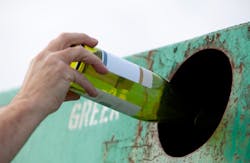With more than 11 million tons of glass collected and recycled in 2011, average glass recycling rates in the European Union for the first time broke the 70% barrier, according to a new report from the European Container Glass Federation (FEVE).
Despite progress made across all European Union countries in average collection and recycling rates, plenty of room remains for improvement, FEVE notes, with about 30% of used glass still being wasted.
The report acknowledges efforts made by all EU member states over the past few years to comply with the EU’s glass recycling target of 60%. This target was met in 2008 and recycling rates have increased ever since. However, regional variations in performance are huge, with several countries achieving excellent results, such as Belgium, which recycled more than 98% of its glass. Others, including Malta (6%), Romania (25.5%) and Cyprus (35%) have a ways to go.
Credit for success
Improving results are attributed partly to glass-industry efforts, including the design, manufacture and sale of containers that allow effective recycling and promotion of recycling to consumers. In addition, collecting and recycling processes are "dramatically" better, the report claims.
Stefan Jaenecke, president of FEVE, said the European Union was fully prepared to absorb more recycled glass, provided it was of high quality. The phrase, "choosing glass" is an essential expression of European plans to achieve a zero-waste economy, due to the material’s infinitely recyclable properties, he added.
Glass is made of natural minerals — sand, soda-ash and limestone — and is entirely recyclable. FEVE says consumers should be encouraged to buy glass containers for both its environmental and health benefits.
Glass is first sorted to remove metallic elements and ceramics, which are not recyclable. Bottle caps and labels are then removed using a blower. Finally, the glass is ground and used for new containers.
Where to look
To educate consumers about the goodness of using glass and the recycling of it, FEVE produced an infographic offering key statistics. Besides showing that more than 70% of all glass bottles and jars sold are collected for recycling, it documents that 82% of those recyclable materials go to make new bottles and jars.
This beneficent cycle helps EU member states save more than 12 million tons of raw material for glass production — an amount sufficient to construct two Egyptian pyramids. Moreover, it forestalls 7 million tons of carbon dioxide from being released into the atmosphere, equal to taking 4 million cars off the road.
Per capita, overall, four in five Europeans regularly recycle their glass bottles, the infographic indicates.
